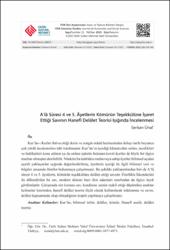| dc.contributor.author | Ünal, Serkan | |
| dc.date.accessioned | 2023-12-26T08:44:41Z | |
| dc.date.available | 2023-12-26T08:44:41Z | |
| dc.date.issued | 2023 | en_US |
| dc.identifier.citation | ÜNAL, Serkan. "Aʻlâ Sûresi 4 ve 5. Âyetlerin Kömürün Teşekkülüne İşaret Ettiği Savının Hanefî Delâlet Teorisi Işığında İncelenmesi." FSM İlmî Araştırmalar İnsan ve Toplum Bilimleri Dergisi, 22 (2023): 435-460. | en_US |
| dc.identifier.uri | https://dergipark.org.tr/tr/pub/fsmia/issue/81557/1408531 | |
| dc.identifier.uri | https://hdl.handle.net/11352/4708 | |
| dc.description.abstract | Kur’ân-ı Kerîm ihtiva ettiği derin ve zengin mânâ hazinesinden dolayı tarih boyunca
çok yönlü incelemelere tabi tutulmuştur. Kur’ân’ın içerdiği kâinata dair sırları, incelikleri
ve hakîkatleri konu edinen ya da onlara işârette bulunan kevnî âyetler de böyle bir ilgiye
mazhar olmuştur denilebilir. Nitekim bu kabilden muhtevaya sahip âyetler bilimsel açıdan
çeşitli yaklaşımlar ışığında değerlendirilmiş, âyetlerin içeriği ile ilgili bilimsel veri ve
bilgiler arasında ilintiler bulunmaya çalışılmıştır. Bu şekilde yaklaşımlardan biri de Aʻlâ
sûresi 4 ve 5. âyetlerin, kömürün teşekkülüne delâlet ettiği savıdır. Özellikle İskenderânî
ile dillendirilen bu sav, modern dönem bazı ilim adamları tarafından da ilgiye layık
görülmüştür. Çalışmada söz konusu sav, kendisine zemin teşkil ettiği düşünülen anahtar
kelimeler üzerinden, hanefî delâlet teorisi ölçüt olarak kullanılarak irdelenmiş ve savın,
delâlet kapsamında olup olmadığının tespiti yapılmaya çalışılmıştır. | en_US |
| dc.description.abstract | The Quran has been subjected to versatile analysis throughout history due to the
deep and rich treasure of meaning it contains. It can be said that the Qur’anic verses that
deal with or point to the secrets, subtleties, and truths of the universe, have also been
subjected to such an interest. As a matter of fact, verses with such content have been
scientifically evaluated in the light of various approaches, and attempts have been made
to find correlations between the content of the verses and scientific data and information.
One of such approaches is the claim that the 4th and 5th verses of Surah al-Aʻlâ indicate
the formation of coal. This thesis, especially voiced by al-Iskenderani, has been deemed
worthy of attention by some scholars of the modern period. In this study, this argument is
analyzed by using the Hanafī theory of evidentiality as a criterion through the key words
that are thought to form the basis for it, and it is tried to determine whether the argument
is within the scope of evidentiality or not. | en_US |
| dc.language.iso | tur | en_US |
| dc.publisher | FSM Vakıf Üniversitesi | en_US |
| dc.relation.isversionof | 10.16947/fsmia.1408531 | en_US |
| dc.rights | info:eu-repo/semantics/openAccess | en_US |
| dc.subject | Kur’ân | en_US |
| dc.subject | Bilimsel Tefsir | en_US |
| dc.subject | Delâlet | en_US |
| dc.subject | Kömür | en_US |
| dc.subject | Hanefî Usulü | en_US |
| dc.subject | Delâlet Teorisi | en_US |
| dc.subject | The Quran | en_US |
| dc.subject | Scientific Tafsir | en_US |
| dc.subject | Heresy | en_US |
| dc.subject | Coal | en_US |
| dc.subject | Hanafi School | en_US |
| dc.subject | Theory of Dalalah | en_US |
| dc.title | Aʻlâ Sûresi 4 ve 5. Âyetlerin Kömürün Teşekkülüne İşaret Ettiği Savının Hanefî Delâlet Teorisi Işığında İncelenmesi | en_US |
| dc.title.alternative | The Analysis of the Argument that the 4th and 5th Verses of Surah Al-A‘la Indicate the Formation of Coal in the Light of the Hanafi School’s Theory of Dalalah | en_US |
| dc.type | article | en_US |
| dc.relation.journal | FSM İlmî Araştırmalar İnsan ve Toplum Bilimleri Dergisi | en_US |
| dc.contributor.department | FSM Vakıf Üniversitesi, Rektörlük, FSM İlmî Araştırmalar İnsan ve Toplum Bilimleri Dergisi | en_US |
| dc.contributor.authorID | https://orcid.org/0009-0001-3877-4971 | en_US |
| dc.identifier.issue | 22 | en_US |
| dc.identifier.startpage | 435 | en_US |
| dc.identifier.endpage | 460 | en_US |
| dc.relation.publicationcategory | Makale - Ulusal Hakemli Dergi - Kurum Öğretim Elemanı | en_US |
| dc.contributor.institutionauthor | Ünal, Serkan | |



















